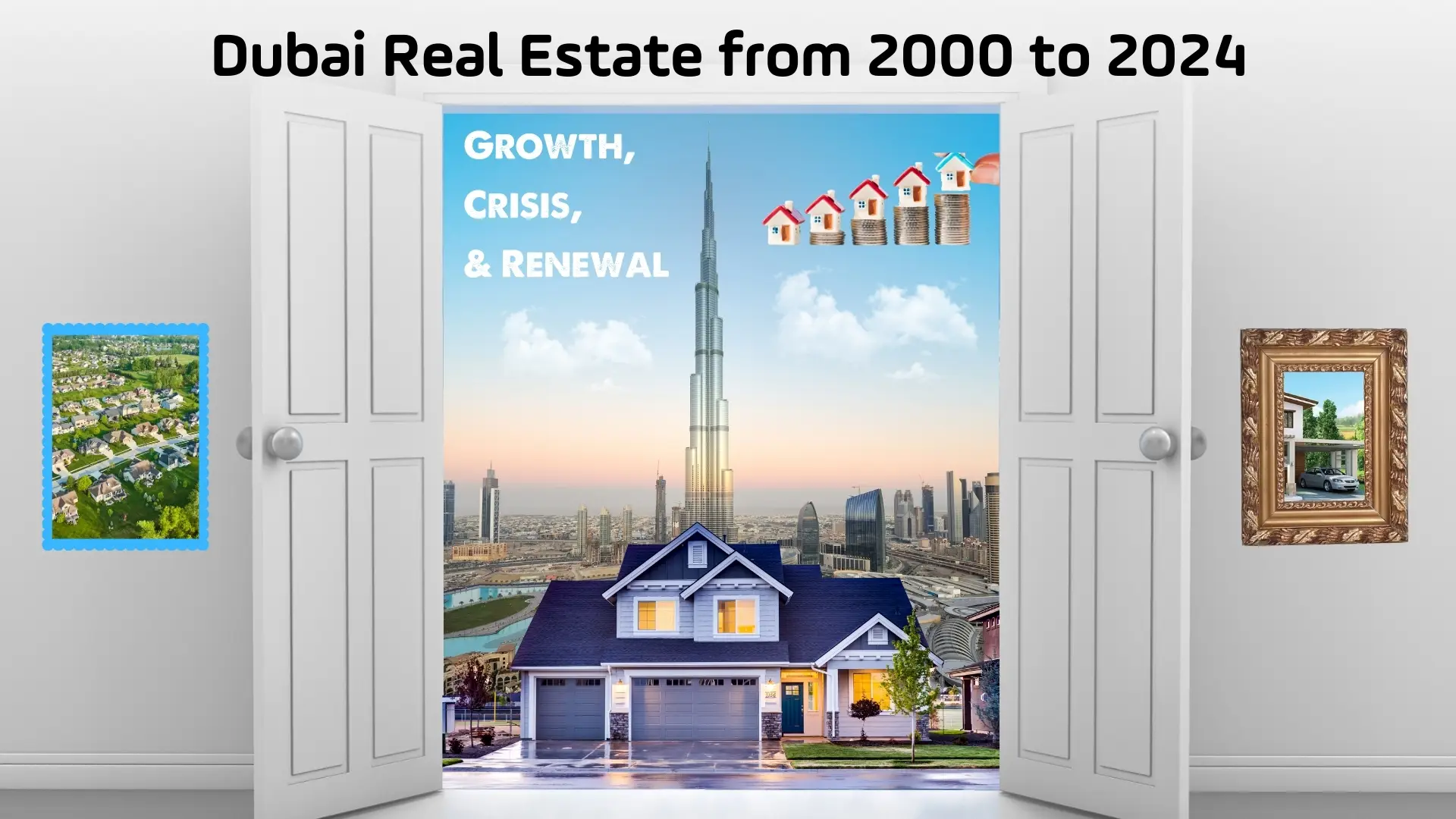Dubai Real Estate from 2000 to 2024: Growth, Crisis, and Renewal

Dubai’s real estate market, from 2000 to 2024, stands as a powerful case study of urban transformation, resilience, and forward-thinking. Over these two decades, the city has navigated both explosive growth and significant challenges, emerging as a leading global property destination. This article explores how Dubai’s real estate journey reflects its commitment to innovation, sustainability, and adaptability in a dynamic global environment.
The Early Years: Dubai’s Real Estate Awakening (2000-2002)
In 2000, Dubai began its ambitious transformation into a global hub. A defining moment came in 2002 when Sheikh Mohammed bin Rashid Al Maktoum allowed foreign ownership of freehold properties in designated areas. This policy change marked the beginning of Dubai’s real estate boom, drawing global interest and laying the groundwork for what would become one of the world’s most vibrant property markets. [Engel & Voelkers]
Boom Years and the Rise of Iconic Developments (2003-2008)
The period from 2003 to 2008 saw explosive growth in Dubai’s real estate market. Groundbreaking projects like the Palm Jumeirah, Dubai Marina, and Downtown Dubai redefined city living. The majestic Burj Khalifa started to take shape, embodying Dubai’s bold vision. Foreign investment and expatriate interest fueled this rapid expansion, driving up property prices at an unprecedented rate.
Speculation in the market led to soaring prices, often doubling or tripling in short spans. This period of rapid growth was followed by a challenging phase as the global economy hit turbulence.
Facing the Global Financial Crisis (2008-2011)
The 2008 financial crisis significantly impacted Dubai, sending property prices plummeting by as much as 50% in some areas. Numerous projects were delayed or halted, financing dried up, and investor confidence took a hit. Dubai’s government responded with decisive action, restructuring debt and creating the Real Estate Regulatory Agency (RERA) in 2007 to bring transparency and order to the market. These measures helped lay the foundation for a more stable and regulated property landscape. [Executive Magazine, 2009]
A New Chapter: Recovery and Expo 2020 Anticipation (2012-2014)
By 2012, Dubai’s real estate market was beginning to recover. The big boost came in 2013 when Dubai won the bid to host Expo 2020, sparking renewed optimism and activity. Developers resumed projects, and new developments were launched with an eye toward Expo 2020’s potential impact. Property values rose steadily, but this time the growth was measured, backed by long-term prospects rather than pure speculation.
Stability and Sustainable Growth (2015-2019)
By 2015, Dubai’s real estate market had entered a more mature phase, characterized by stability and sustainable growth. The government introduced policies to curb speculative buying, such as mortgage caps and transaction fee increases. The focus shifted to affordable housing to meet the needs of a growing middle-class population, and new communities like Dubai South emphasized livable environments rather than just luxury.
This focus on sustainability and balanced development laid the groundwork for a more resilient market. [Khaleej Times, 2019]
Recovery and Resilience Through the Pandemic Years (2020-2021)
The COVID-19 pandemic brought new challenges to Dubai’s property market. Initially, transactions slowed, and uncertainty loomed. However, Dubai rebounded quickly, aided by government stimulus, visa reforms, and flexible payment plans that attracted buyers back into the market. The luxury segment saw strong demand as high-net-worth individuals viewed Dubai as a safe haven during the pandemic, especially in villa communities like Palm Jumeirah and Emirates Hills.
The Expo Effect and a Sustainable Future (2022-2024)
Though delayed, Expo 2020 was held in 2021-2022 and gave Dubai’s real estate sector a substantial boost. The event attracted global attention, increasing demand for residential and commercial spaces. The introduction of new visa options, such as the Golden Visa, made Dubai an even more attractive investment destination. By 2024, Dubai’s focus had expanded to sustainable development, with initiatives like Dubai Creek Tower and the Dubai Urban Master Plan 2040 ensuring that growth aligns with environmental and social goals. [Dubai Municipality, 2024]
A Look Ahead: Dubai’s Real Estate Market of the Future
The journey of Dubai’s real estate market from 2000 to 2024 is a testament to the city’s adaptability, resilience, and ambition. Moving from a regional hub to a global symbol of innovation, Dubai has demonstrated that its real estate market is more than just a collection of impressive buildings. It’s a vision for a future that balances luxury, community, and sustainability.
As Dubai continues to evolve, its focus on sustainable living, technology-driven developments, and community-cantered projects ensures that it will remain a magnet for investors, residents, and visionaries alike.
For inquiries, partnerships, or more details on Dubai’s real estate market and investment opportunities, please feel free to reach out through the following channels:
Phone: +971-43854633
Email: info@sms-realty.com
WhatsApp: +971 52 684 7121 (Chat support available)
Office Address: Pinnacle Building-107, 501 Sheikh Zayed Road, Al Barsha 1, Dubai, UAE

